samedi, 16 mars 2019
La théorie civilisationnelle d’Herman Wirth
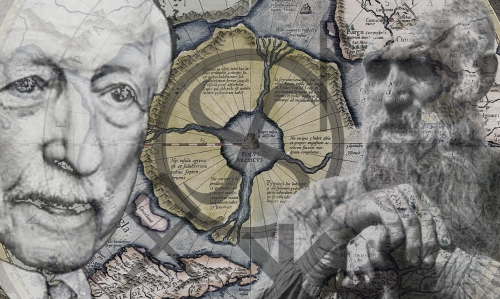
La théorie civilisationnelle d’Herman Wirth
Le Cercle Culturel de Thulé
L’idée de Bachofen d’un matriarcat primordial et sa théorie des « cercles culturels » furent développés par un autre historien et archéologue, un spécialiste en paléo-épigraphie, Herman Wirth (1885-1981).
Les théories de Wirth sont basées sur l’hypothèse empruntée à l’auteur indien Bala Gandhara Tilak (1856-1920) [1], selon qui la civilisation proto-indo-européenne originelle se forma à la fin du Paléolithique (la culture aurignacienne) dans la région du cercle polaire nordique. Cette hypothèse était basée sur l’interprétation des données de l’astrologie indienne, des textes védiques, et des mythes des Hindous, des Iraniens et des Grecs, qui parlent de l’existence dans l’antiquité lointaine d’un pays habité se trouvant dans le Grand Nord (Hyperborée). Ce continent étai décrit dans les Vedas comme la « terre du sanglier blanc », Varahi, et l’« île de lumière », ou Sweta Dvipa. La tradition zoroastrienne parle de l’ancienne résidence du premier homme, la cité de Vara, située dans le Grand Nord, qu’il fut forcé de quitter pour descendre vers le sud quand la déité obscure Angra Mainyu, l’ennemi du dieu de la lumière Ahura-Mazda, déchaîna un « grand froid » sur cette contrée. Tilak affirme l’existence de cette proto-civilisation « nordique » sur la base de l’astrologie indienne, dont le symbolisme, selon Tilak, ne devient clair que si nous acceptons que les constellations furent originellement observées dans les régions circumpolaires, où le jour des dieux est égal à l’année des hommes.
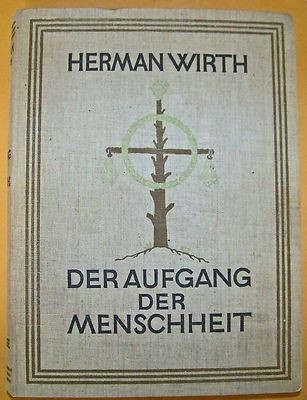 Wirth adopta cette hypothèse et construisit sa propre théorie sur elle, la « théorie hyperboréenne » [2] ou théorie du « cercle culturel de Thulé » [3], qui est le nom grec de la cité mythique se trouvant dans le pays des Hyperboréens. D’après cette théorie, avant la dernière vague de refroidissement mondial, la zone circumpolaire dans l’Océan nord-atlantique abritait des terres habitables dont les habitants furent les créateurs d’un code culturel primordial. Cette culture se forma dans des conditions où l’environnement naturel de l’Arctique n’était pas encore si inhospitalier, et où son climat était similaire au climat tempéré de l’Europe Centrale moderne. Cependant, étaient présents tous les phénomènes annuels et atmosphériques qui peuvent être observés dans l’Arctique aujourd’hui : le jour et la nuit arctiques. Les cycles solaire et lunaire annuels sont structurés différemment de leurs équivalents sous les latitudes moyennes. Ainsi, les fixations symboliques du calendrier, la trajectoire du soleil, de la lune et les constellations du zodiaque avaient forcément une forme différente et des motifs différents.
Wirth adopta cette hypothèse et construisit sa propre théorie sur elle, la « théorie hyperboréenne » [2] ou théorie du « cercle culturel de Thulé » [3], qui est le nom grec de la cité mythique se trouvant dans le pays des Hyperboréens. D’après cette théorie, avant la dernière vague de refroidissement mondial, la zone circumpolaire dans l’Océan nord-atlantique abritait des terres habitables dont les habitants furent les créateurs d’un code culturel primordial. Cette culture se forma dans des conditions où l’environnement naturel de l’Arctique n’était pas encore si inhospitalier, et où son climat était similaire au climat tempéré de l’Europe Centrale moderne. Cependant, étaient présents tous les phénomènes annuels et atmosphériques qui peuvent être observés dans l’Arctique aujourd’hui : le jour et la nuit arctiques. Les cycles solaire et lunaire annuels sont structurés différemment de leurs équivalents sous les latitudes moyennes. Ainsi, les fixations symboliques du calendrier, la trajectoire du soleil, de la lune et les constellations du zodiaque avaient forcément une forme différente et des motifs différents.
A partir d’une énorme quantité de matériel archéologique, paléo-épigraphique (peintures rupestres, symboles paléolithiques, anciennes gravures, etc.), mythologique et philologique, Herman Wirth tenta de reconstruire le système primordial du code culturel de cette proto-civilisation arctique. Au cœur de celui-ci il plaça le proto-calendrier reconstruit, dont les dernières traces sont constituées d’après Wirth par les runes scandinaves, qu’il attribuait à l’antiquité éloignée. Wirth proposa d’examiner ce calendrier, qui enregistre les moments clés de l’année arctique, comme étant la clé de toutes les versions ultérieures des héritages mythologiques, religieux, ritualistes, artistiques et philosophiques qui continuèrent et développèrent cet algorithme primordial au cours des vagues de migrations des porteurs de la « culture thuléenne » dans les régions méridionales. Lorsqu’on les appliqua à d’autres conditions climatiques, cependant, beaucoup des motifs symboliques de ce calendrier, qui étaient parfaitement clairs dans l’Arctique, perdirent leur sens et leur justification. Ils furent partiellement transférés à de nouvelles réalités, partiellement transformés en reliques, et perdirent partiellement leur sens ou en acquirent de nouveaux.
D’abord et avant tout, ce changement entraîna une compréhension fondamentalement nouvelle de l’unité de base du temps : à la place du jour hyperboréen qui est égal à une année, c’est le cercle du jour qui est beaucoup plus clairement défini dans les régions au sud du cercle polaire qui devint la mesure des événements de la vie humaine. De plus, les points indiquant les équinoxes de printemps et d’automne changèrent en relation avec le mouvement en direction du sud. Tout cela obscurcit graduellement la clarté et la simplicité parfaites de la matrice primordiale.
Wirth pensait que sa reconstruction du système sacré de la culture de Thulé se trouvait au cœur de tous les types historiques d’écriture et de langage, ainsi que des tons musicaux, du symbolisme des couleurs, des gestes rituels, des inhumations, des systèmes religieux, etc.
L’étude de cette culture forma la base des tentatives de Wirth pour reconstruire ce qu’il nommait la « proto-écriture » ou « proto-script » de l’humanité. Wirth publia les résultats de ses études dans deux ouvrages monumentaux, Der Aufgang der Menschheit (La marche en avant de l’Humanité) [4] et Die Heilige Urschrift der Menschheit (L’écriture originelle sacrée de l’Humanité) [5], incluant tous deux une grande quantité de tables synoptiques, d’illustrations comparatives de fouilles archéologiques, de systèmes d’écriture, etc.
Matriarcat nordique
Wirth adopta l’idée de Bachofen d’un matriarcat primordial et attribua à la « culture de Thulé » une forme matriarcale de civilisation. Il suggéra que la croyance selon laquelle le genre féminin tend à la matérialité, à la corporéité, à la chtonicité et à des spécificités empiriques est un pur produit de la censure patriarcale, et que le matriarcat pouvait être un phénomène tout aussi spirituel, et même plus, que le patriarcat. Wirth pensait que les sociétés dominées par des femmes, et par des clergés, des religions et des cultes féminins représentaient les types les plus avancés de la culture hyperboréenne, qu’il nommait la « culture des Dames blanches » (weisse Frauen).
 Wirth présenta ainsi une vision très particulière de la relation entre le matriarcat et le patriarcat dans la culture archaïque de la région méditerranéenne. De son point de vue, les plus anciennes formes de culture en Méditerranée furent celles établies par les porteurs du matriarcat hyperboréen, qui en plusieurs étapes descendirent des régions circumpolaires, de l’Atlantique Nord, par voie de mer (et leurs navires avec des trèfles sur la poupe étaient caractéristiques). C’était le peuple mentionné dans les artefacts du Proche-Orient comme les « peuples de la mer », ou am-uru, d’où le nom ethnique des Amorrites. Le nom de Mo-uru, d’après Wirth, était jadis celui du centre principal des Hyperboréens, mais fut donné à de nouveaux centres sacrés par les natifs du Nord dans leurs vagues migratoires. C’est à ces vagues que nous devons les cultures sumérienne, akkadienne, égyptienne (dont l’écriture prédynastique était linéaire), hittite-hourrite, minoenne, mycénienne, et pélagienne. Toutes ces strates hyperboréennes étaient structurées autour de la figure de la Prêtresse Blanche.
Wirth présenta ainsi une vision très particulière de la relation entre le matriarcat et le patriarcat dans la culture archaïque de la région méditerranéenne. De son point de vue, les plus anciennes formes de culture en Méditerranée furent celles établies par les porteurs du matriarcat hyperboréen, qui en plusieurs étapes descendirent des régions circumpolaires, de l’Atlantique Nord, par voie de mer (et leurs navires avec des trèfles sur la poupe étaient caractéristiques). C’était le peuple mentionné dans les artefacts du Proche-Orient comme les « peuples de la mer », ou am-uru, d’où le nom ethnique des Amorrites. Le nom de Mo-uru, d’après Wirth, était jadis celui du centre principal des Hyperboréens, mais fut donné à de nouveaux centres sacrés par les natifs du Nord dans leurs vagues migratoires. C’est à ces vagues que nous devons les cultures sumérienne, akkadienne, égyptienne (dont l’écriture prédynastique était linéaire), hittite-hourrite, minoenne, mycénienne, et pélagienne. Toutes ces strates hyperboréennes étaient structurées autour de la figure de la Prêtresse Blanche.
Le patriarcat, d’après Wirth, fut apporté par des immigrants d’Asie, venant des steppes du Touran, qui déformèrent la tradition hyperboréenne primordiale et imposèrent aux cultures méditerranéennes des valeurs très différentes – primitives, violentes, agressives et utilitaires – qui s’opposèrent (c’est-à-dire qu’elles les dégradèrent) aux formes purement spirituelles du matriarcat nordique.
Ainsi chez Wirth nous avons la reconstruction suivante : le type de culture matriarcale primordial, spirituel et hautement développé du cercle culturel hyperboréen se diffusa à partir d’un centre circumpolaire, principalement par voie de mer, pénétrant en Méditerranée, effleurant l’Afrique, et atteignant même la côte sud de l’Asie jusque dans le Pacifique, où la culture maorie conserve encore des traces de l’ancienne tradition arctique. Une autre branche venant du centre de Mo-uru dans l’Atlantique Nord migra en Amérique du Nord, où elle posa les fondations du code culturel de nombreuses tribus. L’une des entreprises de Wirth fut de démontrer une homologie entre ces deux branches qui étaient issues de la culture de Thulé – la branche européenne, méditerranéenne, et aussi africaine et polynésienne d’une part, et la branche nord-américaine de l’autre [6].
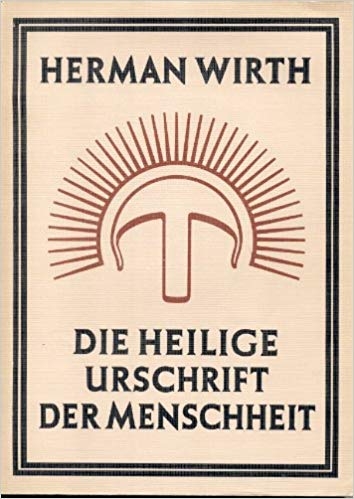 Entretemps se forma en Asie continentale un pôle culturel qui représentait l’embryon du proto-patriarcat. Wirth associait cette culture au naturalisme primitif, aux cultes phalliques, et à un type de culture martial, agressif et utilitaire, que Wirth considérait comme inférieur et asiatique. Nous avons consacré un volume entier à un exposé plus détaillé des idées de Wirth [7].
Entretemps se forma en Asie continentale un pôle culturel qui représentait l’embryon du proto-patriarcat. Wirth associait cette culture au naturalisme primitif, aux cultes phalliques, et à un type de culture martial, agressif et utilitaire, que Wirth considérait comme inférieur et asiatique. Nous avons consacré un volume entier à un exposé plus détaillé des idées de Wirth [7].
La signification des idées de Wirth pour la géosophie
De nombreux aspects des travaux injustement oubliés d’Herman Wirth méritent attention dans l’étude de l’anthropologie plurielle. Avant tout, son hypothèse extrêmement fertile du cercle culturel de Thulé, qui est généralement rejetée d’emblée sans aucune analyse sérieuse de son argumentation, est si riche qu’elle mérite une sérieuse attention à elle seule. Si une telle hypothèse permet la résolution de si nombreux problèmes historiques et archéologiques associés à l’histoire des symboles, des signes, des mythes, des rituels, des hiéroglyphes, du calendrier, de l’écriture et des plus anciennes idées de la structure de l’espace et du temps, alors cela en soi est suffisant pour justifier un examen approfondi. Même si les travaux de Wirth contiennent de nombreuses affirmations qui semblent complètement fausses ou hautement douteuses, nous pouvons les laisser de coté et tenter de comprendre l’essence de sa théorie qui, à notre avis, est une version extraordinairement constructive qui élargit notre compréhension des époques archaïques de l’ancienne histoire de l’humanité. On n’est pas obligé d’accepter inconditionnellement la théorie du cercle culturel de Thulé, mais une évaluation de son potentiel interprétatif est nécessaire.
Deuxièmement, l’évaluation positive du matriarcat par Wirth est extrêmement intéressante et donne du poids aux idées de Bachofen. En effet, nous avons affaire à une interprétation d’une civilisation matriarcale conditionnellement reconstruite à partir de la position de ce qu’est le patriarcat, théorique du moins, auquel notre société s’est habituée. Wirth propose une interprétation alternative du Logos féminin, une tentative de voir le Logos de la Grande Mère avec des yeux différents. C’est aussi une proposition extrêmement non-conventionnelle et fertile.
Troisièmement, dans les théories de Wirth nous pouvons voir de claires analogies avec les reconstructions de Spengler et de Frobenius. Alors que Frobenius et particulièrement Spengler prirent le parti de la culture indo-européenne (touranienne, eurasienne), c’est-à-dire le camp du patriarcat tel qu’ils l’interprétaient, Wirth propose de regarder les choses du point de vue de la civilisation des Dames Blanches, c’est-à-dire depuis la position de la culture méditerranéenne primordiale qui précéda l’invasion des « peuples aux chars de guerre ».
Notes
[1] Tilak, B.G., Arkticheskaiia rodina v Vedakh (Moscow: FAIR-PRESS, 2001). En anglais : Tilak, B.G., The Arctic Home in the Vedas: Being Also a New Key to the Interpretation of Many Vedic Texts and Legends (Poona City: Tilak Bros, 1903).
[2] Dugin, A.G., Znaki Velikogo Norda: Giperboreiskaiia Teoriia (Moscow: Veche, 2008). Une traduction anglaise de l’introduction est disponible ici : http://www.4pt.su/en/content/herman-wirth-runes-great-yul.... Une traduction française a été publiée dans le gros recueil de textes d’Alexandre Douguine, Pour le Front de la Tradition, Ars Magna, 2017, p. 509.
[3] Wirth, H., Khronika Ura-Linda. Drevneishaiia istoriia Evropy (Moscow: Veche, 2007). En allemand : Wirth, Herman. Die Ura-Linda Chronik (Leipzig: Koehler & Amelang, 1933).
[4] Wirth, H., Der Aufgang der Menschheit. Forschungen zur Geschichte der Religion, Symbolik und Schrift der atlantisch-nordischen Rasse (Jena: Diederichs, 1928).
[5] Wirth, H., Die Heilige Urschrift der Menschheit. Symbolgeschichtliche Untersuchungen diesseits und jenseits des Nordatlantik (Leipzig: Koehler & Amelang, 1936).
[6] Le titre complet du livre de Wirth, Die Heilige Urschrift der Menschheit, spécifie « des deux cotés de l’Atlantique Nord ». Voir note 5.
[7] Voir note 2.
Chapitre 22 de la Partie 2, « Théories des Civilisations : critères, concepts, et correspondances », du livre Noomachy: Wars of the Mind – Geosophy – Horizons and Civilizations (Moscou, Akademicheskii Proekt, 2017).
16:23 Publié dans archéologie, Révolution conservatrice | Lien permanent | Commentaires (0) | Tags : alexandre douguine, herman wirth, archéologie, révolution conservatrice |  |
|  del.icio.us |
del.icio.us |  |
|  Digg |
Digg | ![]() Facebook
Facebook
mercredi, 09 janvier 2019
Herman Wirth’s Theory of Civilization
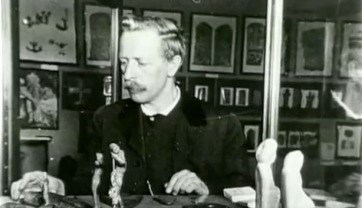
Herman Wirth’s Theory of Civilization
The Cultural Circle of Thule
Bachofen’s idea of a primordial matriarchy and his theory of “cultural circles” were developed by another historian and archaeologist, a specialist in paleo-epigraphy, Herman Wirth (1885-1981).
Wirth’s theories are based on the hypothesis borrowed from the Indian author Bala Gandhara Tilak (1856-1920) [1], that the original Proto-Indo-European civilization was formed in the late Paleolithic (the Aurignacian culture) in the lands of the northern polar circle. This hypothesis was based on the interpretation of the data of Indian astrology, Vedic texts, and the myths of the Hindus, Iranians, and Greeks which speak of the existence in remote antiquity of a populated country lying in the Far North (Hyperborea). This continent was described in the Vedas as the “land of the white boar”, Varahi, and the “island of light”, or Sweta Dvipa. The Zoroastrian tradition speaks of the ancient abode of the first man, the city of Vara, located in the Far North, from which he was forced to descend southwards as the dark deity Angra Mainyu, the enemy of the god of light, Ahura-Mazda, unleashed a “great cold” across these lands. Tilak argues for the existence of this “Nordic” proto-civilization on the basis of Indian astrology, the symbolism of which, according to Tilak, becomes clear only if we accept that the constellations were originally observed in the circumpolar regions, where the day of the gods is equal to the year of men.
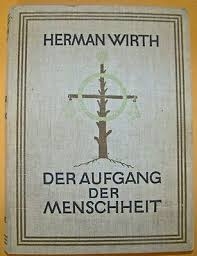 Wirth adopted this hypothesis and constructed his own theory upon it, the “Hyperborean theory” [2] or theory of the “cultural circle of Thule” [3], which represents the Greek name for the mythical city lying in the country of the Hyperboreans. According to this theory, before the latest wave of global cooling, the circumpolar zone in the North Atlantic Ocean was home to inhabitable lands whose inhabitants were the creators of a primordial cultural code. This culture was formed under conditions when the natural environment of the Arctic was not yet so harsh, and when its climate was similar to the modern temperate Central European climate. There were present all the annual and atmospheric phenomena which can be observed in the Arctic today: the Arctic day and Arctic night. The yearly solar and lunar cycles of the Arctic are structured differently than their counterparts in middle-range latitudes. Thus, the symbolic fixations of the calendar, the trajectory of the sun, the moon, and the constellations of the zodiac necessarily had a different form and different patterns.
Wirth adopted this hypothesis and constructed his own theory upon it, the “Hyperborean theory” [2] or theory of the “cultural circle of Thule” [3], which represents the Greek name for the mythical city lying in the country of the Hyperboreans. According to this theory, before the latest wave of global cooling, the circumpolar zone in the North Atlantic Ocean was home to inhabitable lands whose inhabitants were the creators of a primordial cultural code. This culture was formed under conditions when the natural environment of the Arctic was not yet so harsh, and when its climate was similar to the modern temperate Central European climate. There were present all the annual and atmospheric phenomena which can be observed in the Arctic today: the Arctic day and Arctic night. The yearly solar and lunar cycles of the Arctic are structured differently than their counterparts in middle-range latitudes. Thus, the symbolic fixations of the calendar, the trajectory of the sun, the moon, and the constellations of the zodiac necessarily had a different form and different patterns.
On the basis of an enormous swathe of archaeological, paleo-epigraphical (cave paintings, Paleolithic symbols, ancient carvings, etc.), mythological, and philological material, Herman Wirth undertook an attempt to reconstruct the primordial system of this Arctic proto-civilization’s cultural code. At its heart he put the reconstructed proto-calendar, the last traces of which Wirth believed are constituted by the Scandinavian runes, which he attributed to remote antiquity. Wirth proposed to examine this calendar, which records the key moments of the Arctic year, as the key to all later versions of mythological, religious, ritualistic, artistic, and philosophical heritages which continued and developed this primordial algorithm over the course of the wave-like migrations of the bearers of “Thulean culture” into the southern regions. When applied to other climatic conditions, however, many of the symbolic patterns of this calendar, otherwise crystal clear in the Arctic, lost their meaning and rationale. They were partially transferred to new realities, partially frozen as relics, and partially lost their meanings or acquired new ones.
First and foremost, this change entailed a fundamentally new understanding of the basic unit of time: instead of the Hyperborean day, equal to a year, the daily circle, which is much more clearly defined in the regions south of the polar circle, became the measure of events of human life. What is more, the localizing points of the spring and autumn equinoxes changed in relation to southward movement. All of this gradually confused the crystal clarity and simplicity of the primordial matrix.
Wirth believed that his reconstruction of the sacred complex of the culture of Thule lay at the heart of all historical types of writing and language, as well as musical tones, the symbolism of colors, ritual gestures, burials, religious complexes, etc.
Studying this culture formed the basis of Wirth’s attempts at reconstructing what he called the “proto-writing” or “proto-script” of humanity. Wirth published the results of his studies in two monumental works, Der Aufgang der Menschheit (The Emergence of Mankind) [4] and Die Heilige Urschrift der Menschheit (The Sacred Proto-Script of Mankind) [5], both equipped with an enormous lot of synoptic tables, comparative illustrations of archaeological excavations, writing systems, etc.
Nordic matriarchy
Wirth embraced Bachofen’s notion of primordial matriarchy and attributed to the “Thule culture” a matriarchal form of civilization. He suggested that the belief that the female gender is inclined towards materiality, corporeality, chthonicity, and empirical specifics is purely a product of patriarchal censorship, and that matriarchy could be no less, indeed even more of a spiritual phenomenon than patriarchy. Wirth believed that societies dominated by women and female priesthoods, religions, and cults represented the more advanced types of Hyperborean culture, which he termed the “culture of White Ladies” (weisse Frauen).
 Wirth thus presented an altogether peculiar view on the relationship between matriarchy and patriarchy in the archaic culture of the Mediterranean region. In his point of view, the most ancient forms of culture in the Mediterranean were those established by bearers of the Hyperborean matriarchy, who in several stages descended from the circumpolar regions, from the North Atlantic, by sea (and that ships with shamrocks on the stern were characteristic of them). These were the people mentioned in ancient Near Eastern artifacts as the “sea-peoples”, or am-uru, hence the ethnic name of the Amorites. The name Mo-uru, according to Wirth, once belonged to the very main center of the Hyperboreans, but was transmitted along with the natives of the North in their migration waves to new sacred centers. It is to these waves that we owe the Sumerian, Akkadian, Egyptian (whose pre-dynastic writing was linear), Hittite-Hurrian, Minoan, Mycenaean, and Pelasgian cultures. All of these Hyperborean strata were structured around the figure of the White Priestess.
Wirth thus presented an altogether peculiar view on the relationship between matriarchy and patriarchy in the archaic culture of the Mediterranean region. In his point of view, the most ancient forms of culture in the Mediterranean were those established by bearers of the Hyperborean matriarchy, who in several stages descended from the circumpolar regions, from the North Atlantic, by sea (and that ships with shamrocks on the stern were characteristic of them). These were the people mentioned in ancient Near Eastern artifacts as the “sea-peoples”, or am-uru, hence the ethnic name of the Amorites. The name Mo-uru, according to Wirth, once belonged to the very main center of the Hyperboreans, but was transmitted along with the natives of the North in their migration waves to new sacred centers. It is to these waves that we owe the Sumerian, Akkadian, Egyptian (whose pre-dynastic writing was linear), Hittite-Hurrian, Minoan, Mycenaean, and Pelasgian cultures. All of these Hyperborean strata were structured around the figure of the White Priestess.
Patriarchy, according to Wirth, was brought by immigrants from Asia, from the steppe zones of Turan, who distorted the primordial Hyperborean tradition and imposed upon the Mediterranean cultures quite different – rude, violent, aggressive, and utilitarian -values which contrasted (for worse) the pure spiritual forms of the Nordic matriarchy.
Thus, in Wirth we have the following reconstruction: the Hyperborean cultural circle’s primordial, spiritual and highly-developed type of matriarchal culture spread from a circumpolar center, mainly be sea, penetrating the Mediterranean, scraping Africa, and even reaching the southern coast of Asia all the way down to Polynesia, where the Maori culture still retains traces of the ancient Arctic tradition. Another offshoot of the center of Mo-uru in the North Atlantic migrated to North America, where it laid the foundations of the cultural code of many tribes. One of Wirth’s undertakings was to demonstrate a homology between these two branches that dispersed out of the culture of Thule – the European, Mediterranean, and further African and Pacific on the one hand, and the North-American on the other.[6]
Meanwhile, in continental Asia there formed a cultural pole which represented the embryo of proto-patriarchy. Wirth associated this culture with crude naturalism, phallic cults, and a martial, aggressive, and utilitarian type of culture, which Wirth believed to be lower and Asian. We have devoted a whole separate volume to a more detailed outline of Herman Wirth’s views.[7]
The significance of Wirth’s ideas to geosophy
Many aspects of Herman Wirth’s unjustly forgotten works deserve attention in the study of plural anthropology. First of all, his extremely fertile hypothesis of the cultural circle of Thule, which is usually discarded from the outset without any careful analysis of his argumentation, is so rich that it deserves serious attention in itself. If such an hypothesis allows for the resolution of such numerous historical and archaeological problems associated with the history of symbols, signs, myths, rituals, hieroglyphs, the calendar, writing, and the most ancient views of the structure of space and time, then this alone is enough to warrant thorough inquiry. Even though Wirth’s works contain many claims which seem either unequivocally wrong or highly controversial, we can set them aside and try to understand the essence of his theory which, in our opinion, is an extraordinarily constructive version that expands our understanding of the archaic epochs of the ancient history of mankind. The theory of the cultural circle of Thule need not be unconditionally accepted, but an assessment of its interpretive potential is necessary.
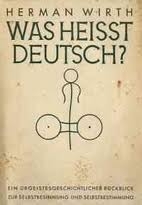 Secondly, Wirth’s positive appraisal of matriarchy is extremely interesting and adds weight to sympathy for Bachofen. Indeed, we are dealing with an interpretation of a conditionally reconstructed matriarchal civilization from the position of what is the, in the very least nominal, patriarchy to which our society has become accustomed. Wirth proposes an alternative interpretation of the female Logos, an attempt to view the Logos of the Great Mother through different eyes. This is also an extremely unconventional and fertile proposal.
Secondly, Wirth’s positive appraisal of matriarchy is extremely interesting and adds weight to sympathy for Bachofen. Indeed, we are dealing with an interpretation of a conditionally reconstructed matriarchal civilization from the position of what is the, in the very least nominal, patriarchy to which our society has become accustomed. Wirth proposes an alternative interpretation of the female Logos, an attempt to view the Logos of the Great Mother through different eyes. This is also an extremely unconventional and fertile proposal.
Thirdly, in Wirth’s theories we can see clear analogues to the reconstructions of both Spengler and Frobenius. If Frobenius and especially Spengler took the side of Indo-European (Turanian, Eurasian) culture, i.e., the side of patriarchy as they interpreted it, then Wirth proposes to look at things from the standpoint of the civilization of the White Ladies, i.e., from the position of the primordial Mediterranean culture that preceded the invasion of the “people on war chariots.”
Footnotes:
[1] Tilak, B.G., Arkticheskaiia rodina v Vedakh (Moscow: FAIR-PRESS, 2001). In English: Tilak, B.G., The Arctic Home in the Vedas: Being Also a New Key to the Interpretation of Many Vedic Texts and Legends (Poona City: Tilak Bros, 1903).
[2] Dugin, A.G., Znaki Velikogo Norda: Giperboreiskaiia Teoriia (Moscow: Veche, 2008). English translation of introduction available here.
[3] Wirth, H., Khronika Ura-Linda. Drevneishaiia istoriia Evropy (Moscow: Veche, 2007). In German: Wirth, Herman. Die Ura-Linda Chronik (Leipzig: Koehler & Amelang, 1933).
[4] Wirth, H., Der Aufgang der Menschheit. Forschungen zur Geschichte der Religion, Symbolik und Schrift der atlantisch-nordischen Rasse (Jena: Diederichs, 1928).
[5] Wirth, H., Die Heilige Urschrift der Menschheit. Symbolgeschichtliche Untersuchungen diesseits und jenseits des Nordatlantik (Leipzig: Koehler & Amelang, 1936).
[6] The full title of Wirth’s Die Heilige Urschrift der Menschheit specifies “on both sides of the North Atlantic.” See footnote 5.
[7] See footnote 2.
Translator: Jafe Arnold
Chapter 22 of Part 2, “Theories of Civilizations: Criteria, Concepts, and Correspondences”, of Noomachy: Wars of the Mind – Geosophy – Horizons and Civilizations (Moscow, Akademicheskii Proekt, 2017).
00:42 Publié dans Révolution conservatrice, Traditions | Lien permanent | Commentaires (0) | Tags : herman wirth, théorie de la civilisation, tradition, traditions, traditionalisme, alexandre douguine, révolution conservatrice |  |
|  del.icio.us |
del.icio.us |  |
|  Digg |
Digg | ![]() Facebook
Facebook


